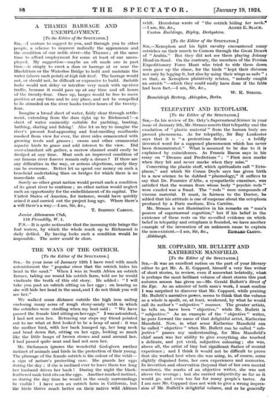THE WAYS OF THE OSTRICH. [To the Editor of the
SPECTATOR.] SIR,—In your issue of January 12th I have read with much astonishment the " popular error that the ostrich hides his head in the sand." When I was in South Africa an ostrich farmer, taking me round his ostrich farm, told me he would vindicate the truth of this old story. He added : " I will take you past an ostrich sitting on her eggs ; on hearing us she will hide her head in the sand, and I do not think you will see her."
We walked some distance outside the high iron railing enclosing many acres of rough stony-sandy veldt in which the ostriches were strolling when my host said : " We have passed the female bird sitting on her eggs." I was astonished, I had not seen her. Retracing our steps my friend pointed out to me what at first looked to be a heap of sand : it was the mother bird, with her back humped up, her long neck and head down flat, sitting on her eggs, looking so much like the little heaps of brown stones and sand around her. I had passed quite near and had not seen her.
Mr. Stefansson ignores the wonderful God-given mother instinct of animals and birds in the protection of their young.
The plumage of the female ostrich is the colour of the veldt—.a sign of nature's protecting care. She guards her eggs
during the day ; if she is inclined ever to leave them too long her husband drives her back During the night the black- feathered male bird sits on the eggs. Another marked instinct, as during the day time he would in the sandy surroundings be visible ! I have seen an ostrich farm in California, but the birds thrive' much better on their native wild African veldt. Herodotus wrote of "the ostrich hiding her neck."
—I am, Sir, &c., AGNES E. SLACK. Caxton Buildings, Ripley, Derbyshire.










































 Previous page
Previous page